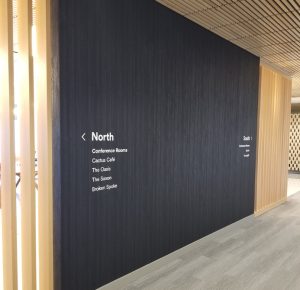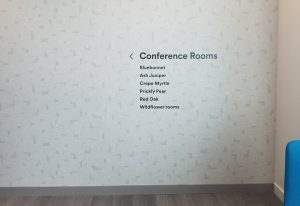Brand Ink is a graphics and branding specialist (handling design, print, and install all under one roof) that works on vehicle and fleet wraps, floor and wall  graphics, and event signage (“A Solid Branding Approach,” September 2019). They also implement wayfinding graphics systems, and because of this, we spoke with Nick Lowry, president of Brand Ink, to learn some of their best practices in this area.
graphics, and event signage (“A Solid Branding Approach,” September 2019). They also implement wayfinding graphics systems, and because of this, we spoke with Nick Lowry, president of Brand Ink, to learn some of their best practices in this area.
When it comes to wayfinding graphics, Brand Ink works both in dimensional (door and wall placards, cut letters, directional panels, etc.) and graphic films. For 2D wayfinding purposes, Brand ink uses 3M graphics films, whether placed directly onto the walls themselves (many times, Controltac™ IJ180C with 8915 overlam) or utilizing it as part of a different layer. “We also apply films to Sintra®, Dibond®, and acrylic,” says Lowry.
They will typically work with the architectural firm designing the building or space and often be in charge of installing the wayfinding system provided to them matching the space. (Note: They also come up with systems on their own, although Lowry says this is less common.)
Brand Ink performs site surveys as well as accepts specs from the architects. Their approach here really depends on what phase the project is in. “If it’s a large construction project, you’re usually involved much earlier in the process, so the space might not be in a state where there’s any point in going out to review it since there are no walls in place,” says Lowry. “Once everything is in place later on, we can then come in and make sure that materials are compatible and look at how we’re going to fasten things to the walls. It’s about going through the process of working our install team through the space efficiently.”
With design, Lowry says the number-one fundamental element is that the wayfinding graphics must be readable and logical. “Beyond that, it’s more about being creative and what you do in terms of materials, finishes, etc., to complement the space,” he says. “It’s about having a high contrast ratio to what’s behind the graphic or letter. My personal preference is to use Sans Serif.
“It depends on whether you walk into a situation where you have the creative control to pose those ideas and breathe life into it or if it’s someone that has come to you with a project where they already have an expert enlisted in that and are just looking to have someone make that a reality.”
Lowry finds that the most important component is having a plan of attack when it comes to doing the actual installation and having lots of communication with the building reps to make sure one’s team will have easy and immediate access to the property upon arriving.
You’re probably going to have a whole lot of unique items that need to go in very specific places. “It’s important to pack things in a way that the installers can unpack them logically and quickly on-site and see where they need to go accurately,” he says. “Whatever you can do to make sure communication is excellent across your team before they show up will pay dividends over the long term.”










